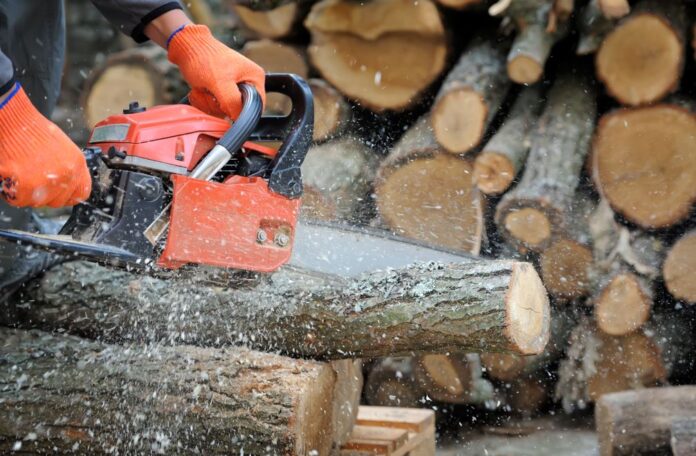When it’s time for use, your chainsaw must produce clean and fast results, so selecting the ideal saw for your job is key. But how do you select it? Which gas or electric chainsaw would work better? We will review their advantages and disadvantages here to help you select the right choice.
Chainsaws come in powers and costs; we will explore and test each type to see which would work best in different woodcutting situations. Read on if you want to know about the differences between gas and electric chainsaws and how they could assist your next woodcutting project.
Electric Chainsaws
Electric chainsaws offer lower sound levels, are lighter in weight, and are easier to use than their counterparts, making them popular among homeowners. Their cord or battery power makes them portable so that you can take them anywhere.
Electric chainsaws are lighter and easier to use than their gas counterparts. Electric models require less maintenance as they do not need oiling or adjustment, saving time and effort when servicing is needed.
Electric Chainsaw Advantages
Electric chainsaws remain invaluable for consumers, even though gas chainsaws are more popular among professionals. Electric chainsaws stand out as being particularly user-friendly, not only due to being lightweight due to the absence of fuel tanks but also by being easy to start. Just push one button to begin cutting – no mixing oil and fuel or fiddling with pull cords or chokes necessary – they start up instantly once your oil tank has been filled up!
Electric chainsaws offer numerous benefits that gasoline models can’t: they are quieter, cleaner, and more efficient without combustion engines releasing fumes and smell, as well as needing less maintenance overall. Electric saws are also cheaper – another reason customers favor them over gasoline models.
Electric Chainsaw DIsadvantages
However, electric chainsaws do have some drawbacks. Their range and run time may be restricted due to limited power output or physical limitations of rechargeable batteries; backup batteries can help alleviate this problem; however, refueling fuel tanks is always more convenient when working remotely.
Electric chainsaws need more strength than professional gas-powered ones, making cutting thicker branches or larger trees with them more challenging.
Gas Chainsaws
Gas chainsaws are more powerful and versatile than their electric counterparts, enabling users to operate them virtually anywhere fuel is available. Furthermore, the gas model’s higher horsepower makes it suitable for more challenging jobs like cutting large trees down quickly or safely from an elevated position.
Due to their internal combustion engines, gas chainsaws are heavier than their electric counterparts; however, most users report finding them easier to manage when cutting. Gas models require additional maintenance, including spark plug and oil adjustments; with proper care, gas chainsaws can last many years longer.
Gas chainsaw advantages
Its Gas-powered chainsaws have many advantages that make them suitable for professional use, including being powerful, portable, and long-lasting. Their powerful engines enable faster cutting speeds resulting in increased job site efficiency. Furthermore, these saws do not rely on power cords or rechargeable batteries and can run wherever fuel is available – not limited by cord length restrictions or rechargeable battery limitations.
Gas-powered chainsaws are known for their flexibility. Gas models offer more bar sizes to match different tasks, while longer bars make cutting through thicker branches easier. Gas models typically support bars of 24 inches, while electric chains typically top 18 inches.
Gas Chainsaw Disadvantages
While gas chainsaws boast impressive power, they also have drawbacks that may put off potential customers. Gas chainsaws tend to be heavier and noisier than their electric counterparts; furthermore, they may produce fumes of gasoline that cling onto clothing, making it hard for users to breathe comfortably while using them.
But that is only half the story – to start an engine, you must either purchase pre-mixed fuel or mix gas and oil yourself to form the correct mixture before starting it up. After that, choke your engine to enhance its fuel mixture for a startup before pulling the cord several times to warm it up before beginning operation. However, an electric chainsaw doesn’t require this additional step. So it is always wise to know what’s involved before purchasing one.
Gas chainsaws are more costly than their electric counterparts, which may put off novice users.
See also: The 7 Saw Types to Use for Home Remodeling
Conclusion
There is no easy way to choose the appropriate chainsaw; everything depends on your requirements. Choose your chainsaw based on what matters to you instead of solely relying on size or guide bar specifications; use our information to help guide your choice and decide what makes sense for yourself based on our advice. Always put safety first by having all necessary equipment when sawing operations are underway – we wish you every success with that endeavor!






















